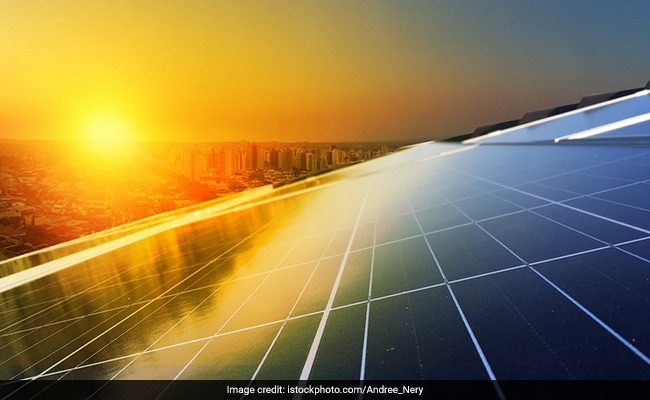- Home/
- Are You Planning To Switch To Solar? Before You Go Ahead Ensure These 5 Things Are In Place
Are You Planning To Switch To Solar? Before You Go Ahead Ensure These 5 Things Are In Place

New Delhi: Of the total energy generated in India in 2018-19, only 2.85% was generated from solar. To reduce the dependency on conventional sources for the generation of energy and expand power generation capacity through renewable energy sources, the central government has set a target of installing 175 Giga Watt (GW) of renewable energy capacity by March 2022. This includes 100 GW from solar, 60 GW from wind, 10 GW from bio-power and 5 GW from small hydro-power.
"The target of installing 100 GW of solar capacity by 2022 in the country is divided into two 40 GW is likely to be achieved by installation of grid connected rooftop solar projects and 60 GW needs to be from large scale solar installations. While we are faring well in installing large scale solar projects and have already installed over 40 GW of solar plants, we are lagging behind in rooftop solar installation. Only 5-6 GW of rooftop solar plants have been put up", says Engineer Alekhya Datta, Fellow and Area Convenor, Electricity and Fuels Division, The Energy and Resources Institute (TERI).
Though thermal power plants that use coal, oil and other fossil fuels are one of the biggest sources of power in India, they are also largest contributors to air pollution globally. Considering the health related complications and environmental implications caused due to toxic gases released from thermal power plants, it's time we switch to renewable sources of energy and what better than solar energy.
"Solar energy is an infinite source of energy. It is clean and green. It doesn't have any cost and is completely emission free", says Dr S.P. Gon Chaudhuri, an Electrical Engineer & International Expert in the field of Renewable Energy.
Switching to solar energy often comes with a bunch of questions & doubts. The cost of installing solar panels is one of the biggest concerns among people. But experts suggest that investing in solar energy is one of the best investments an individual can make.
If you are planning to shift to solar, here are the 5 things you must consider to make the most of it:
Location and Space: The concept and success of solar energy are completely dependent on sun rays. If solar panels will not get an adequate amount of sunlight, they will not be able to produce energy. Therefore, for the placement of solar panels lookout for a ‘shadow free area' – it can be either your roof or balcony or a piece of land next to your house. Just remember, panels need to get sunlight throughout the day.
"Since we are in the northern hemisphere, all our panels should face south to get the maximum sunlight", says Dr Chaudhuri.
Solar panels need a decent amount of space which is why people opt for rooftop. Talking about the space requirement, a senior official from Indraprastha Power Generation Company Limited (IPGCL) says, "You need 10 sq metre area for the installation of 1 kiloWatt (kW) capacity solar power plant. Also, in Delhi, the majority of the people live in flats so the person living on the top floor should have roof right for the installation of solar power plant."Avail Benefits Through Government Policies: The MNRE (Ministry of New and Renewable Energy) under the Government of India offers subsidy to households willing to install solar panels. The subsidy varies from state to state and the capacity of the solar power plant. Hence, it is suggested to check for solar policies specific to your state and look out for available benefits.
"Under phase 2, MNRE provides a subsidy of 40 per cent of the total investment to households installing solar power plant upto a capacity of 3 kW and a subsidy of 20 per cent of investment for a system of 3 kW to 10kW. This is applicable only to states belonging to general category. There are some special category states and Union Territories (UTs) like Jammu and Kashmir, Andaman and Nicobar who are eligible for higher subsidy", says an official from IPGCL.Model of Installation: For installing a solar power plant, an individual has two models to choose from – CAPEX (capital expenditure) model and RESCO (Renewable Energy Service Company) model. In simpler language, as the name suggests, under the CAPEX model, an individual wishing to switch to solar has to bear the entire cost of investment. Though the initial investment is high, but one can easily recover the capital in the next four years.
"Our Bungalow spread across 3,500 sq ft demands meticulous use of energy. At one point, we used to draw energy bill of Rs. 6,000 to Rs. 7,000 per month. Also, in our area, there were regular power cuts. To put an end to both the problems, in 2014, we decided to shift to solar. Our decision turned out to be beneficial and today, on an average, our monthly energy bill stands at Rs. 150", says 67-year-old Leena George from Elamkulam in Kochi.
Back in 2014, when solar was at a nascent stage, Ms George had to invest Rs. 11.5 lakh for the installation of 24 panels having a capacity of producing 6 kW of solar energy.
"Installation of a solar power plant is commercially viable now. The payback period is only 4-5 years and practically there is no running cost", says Dr Chaudhari.
In comparison to CAPEX, the RESCO model is a zero-investment model. A consumer just needs to give up his rooftop space for the installation of solar panels and the entire investment is borne by a third party. Explaining its working, Mr Datta says, "Let's say you are aware of the benefits of solar energy and you want to switch to it but don't have required capital. In such a situation, the best option for you is to contact RESCO; they will come to your place, set up solar panels on the rooftop and sign a contract with you for next 25 years stating that you will pay them Rs. 4 for each unit of energy consumed."
The reason behind signing a contract for 25 years is the life of solar panels. Further elaborating on the benefits of RESCO model, Mr Datta says, “Let's say, currently you pay Rs. 6 per unit but with RESCO you have signed the contract for Rs. 4 per unit. So, you are anyway saving Rs. 2 per unit. Also, in the next 25 years, energy price will multiply many folds but again, since, you have signed the contract for 25 years at Rs. 4 per unit, you are safe.”
Dr Chaudhuri believes while CAPEX model is best suited for domestic sector and RESCO works well for institutional sector.Purchase, Operation and Maintenance: While buying solar panels, ensure it is either BIS (Bureau of Indian Standards) certified or IEC (International Electrotechnical Commission). At the time of the purchase, developer provides five years warranty and takes the responsibility of operation and maintenance (O&M) for initial two years. After that for O&M, owner has to either take an AMC (Annual Maintenance Contract) or take on the onus of maintaining the panels.
In order to get maximum from the solar power plant, it is crucial to maintain it well. Talking about the same, Dr Chaudhuri says, "Generally, solar panels are low maintenance. You just have to wipe them fortnightly and you are good to go."Billing mechanism: Establishments generating power using solar panels are billed either via net metering or gross metering. Let's first understand the difference between the two types of billing options.
The energy generated by the solar panels during the day time is first utilised to meet the establishment's or owner's requirement and the excess or unused power is exported to the local DISCOMs' (Distribution Companies) grid on a daily basis.
"Let's say through solar energy you generated 100 units of energy in a month and utilised only 60 units. For the excess 40 units, DISCOM will pay you. In a way, you are selling the excess energy to the government”, explains Pratha Jhawar, Deputy Programme Manager at Centre for Science and Environment (CSE).
Similarly, if someday, your energy requirement is more than the production, you import it from the grid just like you used to do in the absence of solar panels.
“Generally, we have a unidirectional meter which keeps a count of the number of electrical units we have consumed or imported in a month. Based on the units consumed, our monthly energy bill is calculated. But when we get solar panels installed, a unidirectional meter is replaced with a bidirectional meter which keeps a record of both import and export of energy”, says Mr Datta.
At the end of the month, a consumer has to pay for the net energy consumed and that's what net metering is.
As far as gross metering is concerned, there are two separate meters – gross meter and energy meter. The total number of units of solar energy generated is exported to the grid. For daily power requirement, a user imports energy from the grid.
“At the end of the month, on the basis of the import and export, the energy bill is calculated. While DISCOM pays for the solar energy generated by an individual based on the pre decided price, it charges for the import”, says Ms Jhawar.
“Solar Power plant has no recurring expenses and it gives you energy security. By adopting solar energy, one can contribute to the environmental protection”, says Dr Chaudhari as he appealS for a switch to solar energy.
also read
Solar Is The Best Economic Investment, Says Ecologist Who Has Paid Zero Power Bill For Last Three Years
Written by Aastha Ahuja, Edited by Sonia BhaskarMonthly Power Bill Of Just Rs 130, Here's How A Couple In Kochi Did It
Written by Aastha Ahuja, Edited by Sonia BhaskarHimachal Pradesh's The Kalgidhar Society Saves Rs. 3.4 Crore Per Annum By Harnessing The Power Of Solar
Written by Aastha Ahuja, Edited by Sonia Bhaskar
About The Campaign

NDTV in partnership with Luminous has launched an awareness campaign ‘Be A Bijli Donor’ to promote the idea of ‘save power for more power’. The idea is to conserve energy today in order to get more power tomorrow.
We inherently know that saving energy results in low energy bills, but we also need to understand that a unit of energy saved today makes it available for people still living in the dark or facing regular power cuts.
Saving power or conserving energy is about knowing the sources of energy, and areas of wastage and thereby eliminating these through technology and lifestyle changes. For instance, a 100 W (Watt) incandescent (ICL) bulb can be replaced with a 9 W LED bulb offering similar performance in terms of light output, but at far lower consumption of energy.
While a 100 W ICL bulb, used for four hours a day, consumes 146 units of energy per year, a 9 W LED bulb requires only 13.5 units per year. Clearly, switching to LED is a smart choice as it provides the same output while consuming 90 per cent less energy.
The focus of the campaign is to instill the idea of ‘save power for more power’ and in order to do so, the initiative will create awareness about energy efficient products and services, smart ways to reduce power consumption, alternate sources of energy like solar energy and the need to conserve energy. The idea is to address the rising need for energy conservation in India.
As part of the campaign, we will highlight the stories of individuals and organisations who are championing the cause of energy conservation by switching to renewable sources of energy, adopting innovations to reduce energy consumption while enjoying the same output.
The initiative will provide a platform for all stakeholders to share their ideas and work towards the common goal of, ‘Save power for more power’.






